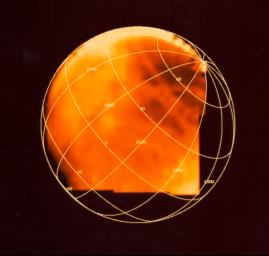
|
Sulfuric Acid on Europa
- Click the image above for a larger view
- Full-Res JPEG (837 x 796) (55.4 kB)
- Full-Res TIFF (837 x 796) (1.2 MB)
Caption:
Frozen sulfuric acid on Jupiter's moon Europa is depicted in this image produced from data gathered by NASA's Galileo spacecraft. The brightest areas, where the yellow is most intense, represent regions of high frozen sulfuric acid concentration. Sulfuric acid is found in battery acid and in Earth's acid rain.
This image is based on data gathered by Galileo's near infrared mapping spectrometer.
Europa's leading hemisphere is toward the bottom right, and there are enhanced concentrations of sulfuric acid in the trailing side of Europa (the upper left side of the image). This is the face of Europa that is struck by sulfur ions coming from Jupiter's innermost moon, Io. The long, narrow features that crisscross Europa also show sulfuric acid that may be from sulfurous material extruded in cracks.
Background Info:
Galileo, launched in 1989, has been orbiting Jupiter and its moons since December 1995. JPL manages the Galileo mission for NASA's Office of Space Science, Washington DC. JPL is a division of the California Institute of Technology, Pasadena, CA.
Cataloging Keywords:
| Name | Value | Additional Values |
|---|---|---|
| Target | Europa | Io, Jupiter |
| System | Jupiter | |
| Target Type | Satellite | Planet |
| Mission | Galileo | |
| Instrument Host | Galileo Orbiter | |
| Host Type | Orbiter | |
| Instrument | Near-Infrared Mapping Spectrometer (NIMS) | |
| Detector | ||
| Extra Keywords | Color, Infrared | |
| Acquisition Date | ||
| Release Date | 1999-09-30 | |
| Date in Caption | ||
| Image Credit | NASA/JPL | |
| Source | photojournal.jpl.nasa.gov/catalog/PIA02500 | |
| Identifier | PIA02500 | |
